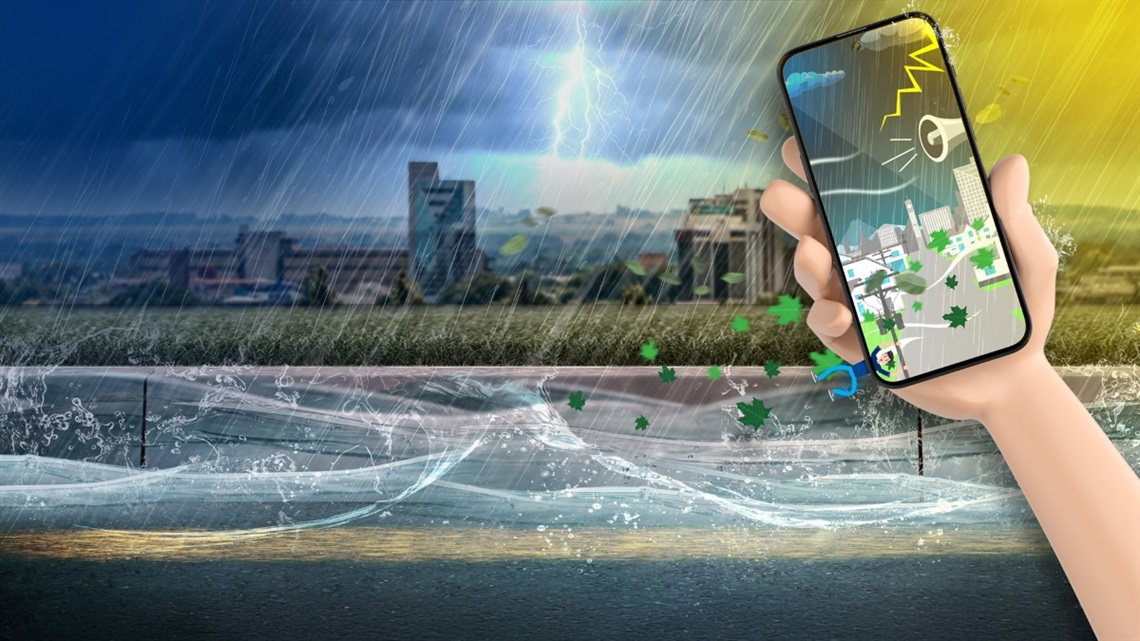Are you ready for Palmerston North’s most likely emergency?
Published on 05 June 2025

Palmerston North residents are being urged to prepare for storms and heavy rain as we head into winter.
Over the past few years, we’ve seen significant weather events across the country, and Palmy is likely to see more over time. In fact, weather events are the most likely civil defence emergencies we face. Over the coming months, we’re running an emergency management campaign to help residents prepare for storm and severe weather events. We’ll also be getting public feedback on our stormwater strategy.
Our city's geography and stormwater system play an important role in managing heavy rainfall, but there are steps residents can take to help stay safe and protect themselves, their property, and their family.
Three waters group manager Mike Monaghan says storms and heavy rain are the most common natural hazards in our city. Palmerston North is built on a flat floodplain, with the Manawatū River and Mangaone Stream acting as the main outlets for stormwater. Our soft clay-based soils don’t absorb much water, often causing rain to run off across land rather than soak into the ground.
“Our stormwater system is designed to handle most small weather events, but during very heavy rain, the volume of water can exceed what the pipes can carry. When that happens, water may temporarily overflow and pond on streets until the system catches up. Drainage reserves help absorb some of this excess, but if drains are blocked by leaves or debris, the ponding can get worse. Residents can help by keeping street and property drains clear—especially in autumn and winter.
Over the past century, we’ve developed an extensive stormwater system designed to handle varying levels of rainfall.
This stormwater system operates on three levels:
- Primary (underground pipes): In normal conditions, stormwater stays within the underground pipe system with no visible water ponding.
- Secondary (street ponding): During heavier rainfall, drains and pipes can reach capacity, causing water to pond on roads or in low-lying areas. This keeps water from entering properties—there’s just simply more water than the system can manage. It’s normal for water to pond up to the kerb level and sometimes just above in low lying areas. If it gets any higher, you can call Council to consider closing the road to prevent vehicles from driving through the water and pushing it into properties.
- Tertiary (drainage reserves): In heavy rainfall, designated green spaces, parks and reserves may temporarily hold excess water when the pipes under the roads are at capacity. This helps to reduce the risk of water entering properties. Examples of these include Rangitāne Park and Norton Park.
When to call the council for help
Mr Monaghan says in heavy rain events, residents only need to call the council contact centre if surface ponding is higher than the roadside kerb, doesn’t recede, and looks like it might enter homes.
“Remember, it’s normal for water to pool in your street and backyard, that’s our stormwater system working. But, it’s important to let us know if the water level is rising and threatens to enter your home. Properties near streams or rivers may be at higher risk, so we also keep a close eye on the main streams, but if you have concerns please get in touch.
Preparing for storms and heavy rain
Emergency management manager Jason McDowell says it’s important everyone knows how to prepare for and respond to storms and heavy rain.
“Severe weather can happen quickly and without warning in Palmerston North, so it’s important we stay safe by being prepared and acting quickly. Heavy rainfall can quickly overwhelm our rivers, streams, and streets. Even if it’s dry in the city, rain in the Ruahine Ranges can impact the Manawatū and Pohangina Rivers.
By following a few easy tips, you can help protect yourself, your whānau and your friends when storms hit:
- Regularly check and clear your gutters and roadside drains to ensure water flows freely.
- When landscaping or building, ensure the ground slopes away from your house and that fences or buildings do not block water from flowing over land.
- Tie down outdoor items like furniture and trampolines, and it’s a good idea to keep your rubbish and recycling bins under shelter.
- Ensure any sleepouts, cabins or habitable rooms are on foundations above the ground or flood level.
- Identify roads that may experience ponding and plan alternative routes.
- Assemble an emergency kit with essential supplies, including food, water, medications, important documents, and a list of key phone numbers and contacts.
- Have a family emergency plan and meeting points. Don’t forget your pets!
Mr McDowell reminds everyone to never enter a river after heavy rainfall or floodwater on the streets. Rivers are unpredictable after heavy rainfall and undercurrents are strong for up to 72 hours.
“Stormwater and floodwater may be deeper than it looks, could be contaminated, or hide unknown hazards like logs or exposed manholes. Don’t walk, drive, or let children play in stormwater.
Win a grab bag for your whānau
Think you’re ready for storms and heavy rain? Take our quick 5-question quiz and you’ll go in the draw to win a grab bag packed with emergency essentials for your whānau. Visit pncc.govt.nz/disasters to enter.
We’ll also provide an update to our community when we open public feedback on our stormwater strategy, which is currently being worked on.
Disasters
Floods and storms